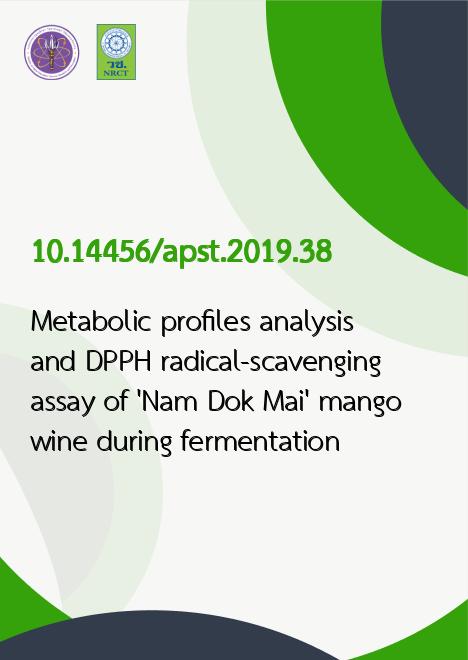
|
Metabolic profiles analysis and DPPH radical-scavenging assay of 'Nam Dok Mai' mango wine during fermentation |
|---|---|
| รหัสดีโอไอ | |
| Creator | Nutthapol Wattanakul |
| Title | Metabolic profiles analysis and DPPH radical-scavenging assay of 'Nam Dok Mai' mango wine during fermentation |
| Contributor | Nutthapol Wattanakul, Sumallika Morakul, Yaowapa Lorjaroenphon, Kriskamol Na Jom1 |
| Publisher | Asia-Pacific Journal of Science and Technology |
| Publication Year | 2562 |
| Journal Title | Asia-Pacific Journal of Science and Technology |
| Journal Vol. | 24 |
| Journal No. | 4 |
| Page no. | 1-7 |
| Keyword | Mango wine, Metabolomics, Metabolic profiles, Phytosterols, Antioxidant |
| URL Website | https://www.tci-thaijo.org/index.php/APST |
| Website title | https://www.tci-thaijo.org/index.php/APST/article/view/185028/158275 |
| ISSN | 2539-6293 |
| Abstract | The 'Nam Dok Mai' mango, a famous fruits known worldwide, is produced and consumed extensively. However, mango is a climacteric fruit with a short shelf-life. Therefore, wine production is an alternative procedure, which can be used to process low-quality mangoes. The metabolic profiles of mango wine during fermentation would present a broadening of low molecular compositions, which might improve the production and quality of mango wine. Using the metabolomic approach, fifty-six peaks could be identified, accounting for approximately 40% of all metabolites. Based on the metabolites found in mango wine, Principal Component Analysis (PCA) coupled with Agglomerative Hierarchical Clustering Analysis (AHC) analysis was processed to differentiate all samples. Oleic acid, linoleic acid (?-6), and ?-linolenic acid (?-3) were significantly decreased during the fermentation periods. The most abundant phytosterols, found in 'Nam Dok Mai' mango wine, were ?-sitosterol, campesterol, and stigmasterol. A decrease in all phytosterols was also found during fermentation. Regarding the polar metabolites, most of the sugars, including sucrose, glucose, and fructose, were depleted by wine yeast during their alcoholic metabolism. Conversely, organic acids, such as malic acid and citric acid, were slightly increased during the fermentation process due to aerobic glycolysis channels. The antioxidant activity in mango wine during fermentation periods was not different. |